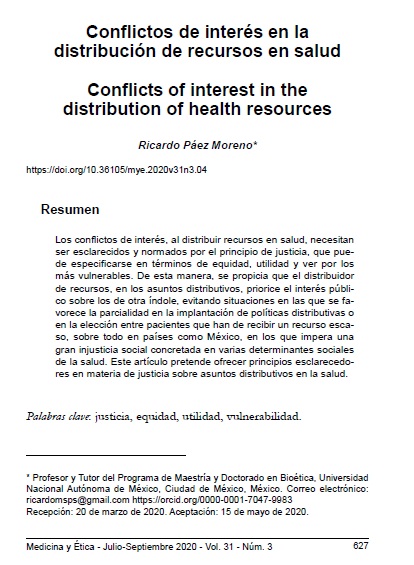Conflictos de interés en la distribución de recursos en salud
DOI:
https://doi.org/10.36105/mye.2020v31n3.04Palabras clave:
justicia, vulnerabilidad, utilidadResumen
Los conflictos de interés, al distribuir recursos en salud, necesitan ser esclarecidos y normados por el principio de justicia, que puede especificarse en términos de equidad, utilidad y ver por los más vulnerables. De esta manera, se propicia que el distribuidor de recursos, en los asuntos distributivos, priorice el interés público sobre los de otra índole, evitando situaciones en las que se favorece la parcialidad en la implantación de políticas distributivas o en la elección entre pacientes que han de recibir un recurso escaso, sobre todo en países como México, en los que impera una gran injusticia social concretada en varias determinantes sociales de la salud. Este artículo pretende ofrecer principios esclarecedores en materia de justicia sobre asuntos distributivos en la salud.
Descargas
Referencias
(2) GRACIA, D. Profesión médica, investigación y justicia sanitaria. Bogotá: El Búho; 1998; Vol. 4: 89-194. ¿Limitación de prestaciones sanitarias?
(3) BROCK D, WIKLER, D. Ethics Issues in Resource Allocation, Research and New Product Development. En: JAMISON, D, editor. Disease Control Priorities in Developing Countries. 2nd ed. Washington, DC. The International Bank for Reconstruction and Development, The World Bank. New York: Oxford University Press; 2006; Chap. 14.
(4) ÁVILA, J. A. ¿Qué es un conflicto de interés?. México: Instituto Nacional de la Nutrición Salvador Zubirán; 2013. Consultado: 22 de marzo de 2020. Disponible en: http://www.innsz.mx/opencms/contenido/investigacion/comiteEtica/conflictointereses.html https://doi.org/10.26723/endoscopia.0188-9893.173.005
(5) ARISTÓTELES. Ética a Nicómaco – Política. Libro V. 20ª ed. México: Porrúa; 2004.
(6) COUCEIRO, A. Los niveles de la justicia sanitaria y la distribución de los recursos, Anales Sis. San. Navarra. 2006; 29 (Supl. 3): 61-74. https://doi.org/10.4321/ s1137-66272006000600007
(7) CÁMARA DE DIPUTADOS DEL H. CONGRESO DE LA UNIÓN. Código Penal Federal. Justia, 2020. Consultado: 14 de marzo de 2020. Disponible en: https://mexico.justia.com/federales/codigos/codigo-penal-federal/libro-segundo/titulo-septimo/capitulo-i/. https://doi.org/10.16925/greylit.2105
(8) ASOCIACIÓN DE ACADEMIAS DE LA LENGUA ESPAÑOLA. Diccionario de la Lengua Española. Madrid: Real Academia Española; 2014. Revisado 2019; Consultado: 22 de marzo de 2020. Disponible en: https://dle.rae.es https://doi.org/10.5944/epos. 25.2009.10627
(9) BEAUCHAMP, T.; CHILDRESS, J. Principles of Biomedical Ethics. 5th ed. Cary NC: Oxford University Press; 2012.
(10) NSTITUTE OF MEDICINE OF THE NATIONAL ACADEMIES. Conflict of Interest in Medical Research, Education and Practice. Washington, DC: National Academies Press; 2009.
(11) SEN, A. The Idea of Justice. Cambridge: Belknap Harvard; 2009.
(12) PÁEZ, R. Igualdad, equidad y justicia. México: Posgrado de Medicina, Facultad de Medicina UNAM: 2018. Consultado: 23 de marzo de 2020. Disponible en: https://www.youtube.com/watch?v=Wl_Mr54jqS0https://doi.org/10.22201/fm.2448486 5e.2019.62.5.10
(13) RAWLS, J. Teoría de la justicia. 2ª ed. México: Fondo de Cultura Económica; 1995.
(14) DANIELS, N. Just Health Care. Cambridge MA: Cambridge University Press; 1985.
(15) VENKATAPURAM, S. Health Justice. Cambridge, MA: Polity Press; 2011.
(16) POWERS, M.; FADEN, R. Social Justice. New York, NY: Oxford University Press; 2006.
(17) ORGANIZACIÓN DE LAS NACIONES UNIDAS. Declaración Universal de los Derechos Humanos. Nueva York: ONU; 1948. Consultado: 16 marzo de 2020. Disponible en: https://www.un.org/es/universal-declaration-human-rights/ https://doi.org/10.2307/j.ctv86dh99.4
(18) ORGANIZACIÓN DE LAS NACIONES UNIDAS. Derecho al disfrute del nivel más alto posible de salud. Nueva York: ONU; 11 de agosto de 2000. Consultado: 16 marzo de 2020. Disponible en: https://www.acnur.org/fileadmin/Documentos/BDL/2001/1451.pdf https://doi.org/10.2307/j.ctt2111g8r.101
(19) ORGANIZACIÓN MUNDIAL DE LA SALUD. Cobertura sanitaria universal. Geneva: OMS; 5 de diciembre de 2018. Consultado: 5 de febrero de 2020. Disponible en: https://www.who.int/es/news-room/fact-sheets/detail/universal-health-coverage-(uhc) https://doi.org/10.21149/spm.v58i5.8182
(20) ORGANIZATION FOR ECONOMIC COOPERATION AND DEVELOPMENT. Extent of Health Care Coverage: Health at a Glance 2019. OECD indicators. París, Cedex: OECD; 2019. Consultado: 5 de febrero de 2020. Disponible en: https://www.oecdilibrary.org/docserver/4dd50c09-en.pdf expires=1585062016&id=id&accname=guest&checksum=2E8C3DF842106DB9EF1684AD26C7816C https://doi.org/10.1787/f2bffe97-en
(21) ORGANIZACIÓN MUNDIAL DE LA SALUD. Subsanar las desigualdades en una generación. Geneva: OMS; 2009. Consultado: 5 de febrero de 2020. Disponible en: https://www.who.int/social_determinants/thecommission/finalreport/en/. Consultado: 22 de marzo de 2020. https://doi.org/10.1177/1757975909103770
(22) FRIED, CH. Right and Wrong. Cambridge, MA: Harvard University Press; 1978.
(23) BUCHANAN, A. The Right to a Decent Minimum of Health Care, Philosophy and Public Affairs. Winter, 1984; 13(1): 55-78.
(24) WORLD HEALTH ORGANIZATION. Making fair choices on the path to universal health coverage. Geneva: WHO; 2014. Consultado: 22 de marzo de 2020. Disponible en: http://apps.who.int/iris/bitstream/handle/10665/112671/9789241507158_eng. pdf;jsessionid=3DACAC0A8D45A35D8E684B4A182F498E?sequence=1
(25) ORGANIZACIÓN PARA LA COOPERACIÓN ECONÓMICA Y EL DESARROLLO. Cómo se compara México. Indicadores de salud. México: OCDE; 2017. Consultado: 22 de marzo de 2020. Disponible en: https://www.oecd.org/mexico/Health-at-a-Glance-2017-Key-Findings-MEXICO-in-Spanish.pdf https://doi.org/10.1787/ayuda_sintesis-2015-51-es
(26) FUNDACIÓN RÍO ARRIONTE, FUNDACIÓN MEXICANA PARA LA SALUD, INSTITUTO NACIONAL DE SALUD PÚBLICA. Prioridades de Investigación en Salud en México. México: INSP; 2017. Consultado: 22 de marzo de 2020. Disponible en: https://www.insp.mx/images/stories/2017/Avisos/docs/170708_Prioridades_invest _salud.pdf https://doi.org/10.21149/spm.v58i5.8244
(27) PÁEZ, R. La investigación biomédica en seres humanos desde la ética pública: el valor social de la investigación. Memorias del XII Congreso de la Federación Latinoamericana de Instituciones de Bioética; 2019; abril, pp. 11-13. Santiago de Chile: FELAIBE; 2020, en prensa. https://doi.org/10.4067/s1726-569x2012000100003
(28) TRINCADO, M. Visión global de la medicina preventiva en Chile. Revista Médica Clínica las Condes. Consultado: 16 de marzo de 2020. 2010; 21(5): 669-673. Disponible en: https://www.elsevier.es/es-revista-revista-medica-clinica-las-condes-202-articulo-vision-global-medicina-preventiva-chile-S0716864 010705873 https://doi.org/10.1016/s0716-8640(10)70587-3
(29) HART, J. T. The Inverse Care Law, Lancet. 1971; 297(7696): 405-412. https://doi. org/10.1016/s0140-6736(71)92410-x
(30) CORONA, R. El sistema de salud en México: de la fragmentación hacia un sistema de salud universal. México: Colegio Nacional de Especialistas en Medicina Integrada; 2017. Consultado: 24 de marzo de 2020. Disponible en: https://www.conaemi.org.mx/single-post/2017/01/15/El-Sistema-de-Salud-en-México-De-lafragmentación-hacia-un-Sistema-de-Salud-Universal https://doi.org/10.1590/s0036-36342003000200011
(31) LEAL, G. ¿Protección social en salud? Ni «seguro», ni «popular». Estudios Políticos; 2013; novena época (núm. 28): 163-193. https://doi.org/10.1016/s0185-1616(13)71444-6
(32) DANIELS, N. Just Health. Meeting Needs Fairly. Cambridge, MA: Cambridge University Press; 2008.
(33) PÁEZ, R. Pautas bioéticas. La industria farmacéutica entre la ciencia y el mercado. 2ª ed. FCE, UNAM: México; 2018.
(34) FRENK, J., GÓMEZ, O., MARIE, F., ORNELAS, A. Salud: monopolio o pluralismo.Nexos. 2018 junio; 486. Consultado: 23 marzo 2020. Disponible en: https://www.nexos.com.mx/?p=37756.
(35) HOLM, S. Private Hospitals in Public Health Systems, Hast. Cent. Rep. 1989; 19 (5): 16-20. https://doi.org/10.2307/3562636
(36) PUYOL, A. Justicia distributiva en el sistema de salud. El racionamiento de los recursos en tiempo de crisis. Juristas de la Salud; 2014; 24(extra 1): 6-13. https://doi.org/10.35537/10915/45971
(37) POST, S. Encyclopedia of Bioethics. 3rd ed. New York: Mac Millan Reference; 2004; Vol. 2: 1107-1116. Health-Care Resources, Allocation of.
(38) CALLAHAN, D. La edad como criterio de limitación de recursos sanitarios. En: Limitación de Prestaciones Sanitarias. Actas de la Jornada de la Fundación de las Ciencias de la Salud. Madrid: Ediciones Doce Calles; 1997; pp. 108-123. https:// doi.org/10.22507/rli.v11n2a3
(39) TEN HAVE, H. Las listas de espera como método de limitación de prestaciones sanitarias. En: Limitación de Prestaciones Sanitarias. Actas de la Jornada de la Fundación de las Ciencias de la Salud. Madrid: Ediciones Doce Calles; 1997; pp. 78-107. https://doi.org/10.4272//978-84-9745-236-6.ch12

Descargas
Publicado
Número
Sección
Licencia
Derechos de autor 2020 Ricardo Paez Moreno

Esta obra está bajo una licencia internacional Creative Commons Atribución-NoComercial-CompartirIgual 4.0.
Medicina y Ética se distribuye bajo Licencia Creative Commons Atribución-NoComercial-CompartirIgual 4.0 Internacional.
El autor conserva los derechos patrimoniales sin restricciones y garantiza a la revista el derecho de ser la primera publicación del trabajo. El autor es libre de depositar la versión publicada en cualquier otro medio, como un repositorio institucional o en su propio sitio web.


























